 |
||
|
||
| ||
The format MP3 for high-quality encoding of sound becomes more and more popular. Initially developed for usage within the standards of video compression MPEG1 and MPEG2 it very fast has received distribution as the independent format. Saving excellent quality of sound at the large degrees of compression and more than active attempts of the corporation - developer IIS Fraunhofer to extract a maximal of the profit from the child became the main reasons of such turn of events. In the basis MP3 is direct development MPEG Layer I and Layer II and psychoacoustic model for coding an original signal is also used in it. Because of it the process of coding is ambiguous and can be varied depending on the used encoder. This ambiguity means that having encoded the same signal by two different encoders we can receive after decoding two signals differing on sounding. It is obvious that that encoder which in the best way saves an original signal is preferable. The purpose of the given review is to clarify which one from modern encoders will give us the best result. Technique of testingUsually to compare initial and encoded signal the method of matching their Amplitude-Frequency Rates (AFR). There are two varieties of this method: matching average AFR signals and matching of change AFR in time. The first one is used more often because of its simplicity- matching is made only once. However at the average the significant part of the information about a signal is lost and as a consequence at absolutely identical AFR initial and encoded signal can rather differ in sounding if in a signal there are large on amplitude but rather short-term change of some frequencies. The second one allows to avoid such problems however it is necessary to make for implementation of testing so huge quantity of calculations with a floating point (fast Fourier transform gives rather quite good results for the analysis of the large blocks samples however for definition AFR in10-20 samples it is absolutely inapplicable) that all process of testing will take some days for a minute of signal CD qualities. To avoid the problem of shortage productivity the technique of testing based on the absolutely other principle was developed. The encoder MP3 actually is the "rough" archiver, at "unpacking" its production it is impossible to restore the initial information completely. So the quality of coding can unambiguously be estimated through percent of saving information. Thus if to subtract the encoded signal from the original signal the result will represent that part of the information which was lost during coding. Average value amplitude of this result will be the parameter defining quality of coding. It was called "average difference of signals" (ADS). However, not all is so good in this method. For example, if to invert a signal concerning its zero level (or just to displace this level a bit) ADS will have the value of a double average level of a signal (or the value of offset zerolevel) in spite of the fact that the signal will sound identically to the initial one (and to have appropriate AFR). Therefore another parameter called "average difference of waveforms" (ADW) became more applicable for the estimation of coding quality. For its definition the initial and coded signals are handled so that each sample instead of deviation amplitude of the speaker from the position of the balance is equal to the value of difference of these amplitudes for previous and this sample (such technique of representation a signal was used in ADPCM coding). For the already processed signals their ADS was calculated which for original signals is ADW. The main difference between ADW and ADS is in usage modules of their differentials for the estimation the difference of signals instead of difference in amplitude. Due to this the waveforms regardless of zerolevel's position are compared. But despite of obvious disadvantages ADS it was decided to use both methods at testing. This solution was motivated by increased requirements to an encoder. Though the standard MP3 also was initially developed as "giving similar sounding, but not identical signals" (that is what words "psychoacoustic model" mean) the maximum saving all parameters of an original signal all the same is the primary task of an encoder because of their obvious correlation with similar sounding. The disadvantages of such method of matching are obvious. ADS and ADW do not contain the information about in what exactly encoded signal loses quality in comparison with initial. Moreover, they cannot be the perfect characteristic the quality of coding at all. The situation when the signal with ADW close to zero for the man will sound the same as the signal with much greater ADW is possible. But at the same time it is impossible for the signal with ADW close to zero to differ strongly in sounding from initial. Therefore ADS and ADW are redundant characteristics and guarantee that the difference between signals won't be more than some level. Therefore first stage of researches was definition of maximum values ADS and ADW at which human ear can not note differences in signals yet. For this purpose "white" noise of a different level was added to sine-wave signals different frequencies (from 200 Hz up to 20ÊHz) of maximum amplitude. The obtained signals were listened together with initial and those threshold values the level of "white" noise at which it is not audible behind the main sine wave signal were determined. For such noise level ADS and ADW were determined which were taken as "measurement standard". In case the coding of a signal gives ADS and ADW smaller than standard the further improvement quality of coding is represented useless. For the values ADS and ADW larger than standard there is a probability of heard difference in signals. However, because of usage psychoacoustic model this probability is rather small even for values ADS and ADW exceeding standard in some times. Among the advantages of this method of matching it is necessary to mark its applicability to any methods of coding a signal. Already now there are some formats of coding a sound that are not yielding on degree compressions MP3 based not on saving the defined part of a frequency spectrum of a signal but on, for example, dynamic change of frequency encoding parameters. For restoring a signal in such methods interpolation techniques are used and the signal obtained in result saves average AFR initial despite of significant differences in local AFR. For such formats of coding the method of matching average AFR is inapplicable because it will give too overestimated results but ADS and ADW will describe quality of coding without problems. Therefore research was not limited by only MP3 format. For example, the rather young standard from Microsoft - WMA also has taken part in it. In process development of technologies and improvement of encoders the results of researches will be enlarged and updated. ToolkitFor realization of researches two programs for operation with a sound and one programming language were used. Winamp v.62 with the decoder MP3 from IIS Fraunhofer (v.2.23) was used for decoding MP3 of files in WAV. Such choice was made because the majority of other decoders/players MP3 use special posts - signal processing for giving them "softer" sounding, while it is necessary for researches of quality coding of a signal in the pure state without any posts - processing. Then saved WAV the file with an encoded signal was exposed to processing in the sound editor GoldWave v4.16. By virtue features of the standard MP3 the encoded signal contains some (defined by an encoder) silence or little noticeable noise before the beginning of a signal. Therefore the real beginning of the sound data was found by the method of visual matching initial and encoded signal and the garbage prior to it was deleted. In several cases some first hundreds of samples from an original signal were not encoded at all. However, for saving exactness it was decided to consider such errors of encoders just as "inaccuracies" in saving a signal and therefore to leave them without notice for all the same they will affect on ADS and ADW. For finding ADW and ADS using Delphi 3 two small programs were written. The first one created two files of the identical format, one of which contained ÐC and the second ÐÔC. The second program found average value given for files of the format results the first one. The used encoders
Audioactive Production Studio v.1.0.5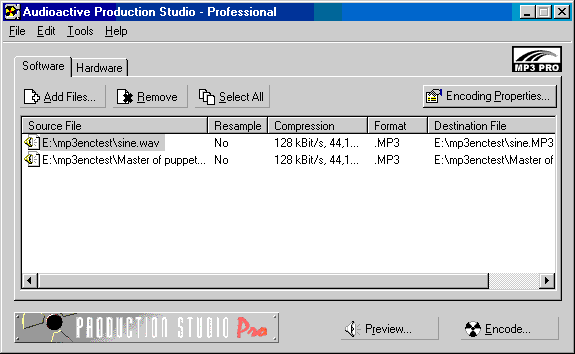 It is based on the code from IIS Fraunhofer and differs from the "native" code only by optimization on speed. It has the simple interface that however is rather convenient for coding a plenty of files. From parameters of coding it is possible to change only bitrate and sort of optimization: on speed and on quality. In case of an incorrect frequency rate for selected citrate resampling is made automatically. The program is able to make not only MP3 file and WAV-MP3 - MP3 encapsulated into RIFF format. One of features is the support of special equipment for the hardware coding of a sound made by the corporation Audioactive. "Saving of perfect quality at speed of coding in real time "is named the main advantage of this equipment. However because of increasing capacity of processors this advantage doesn't play a big role for already on Pentium II 266 we can encode a sound in real time using only "program" encoder that makes purchase of additional equipment deprived of sense. 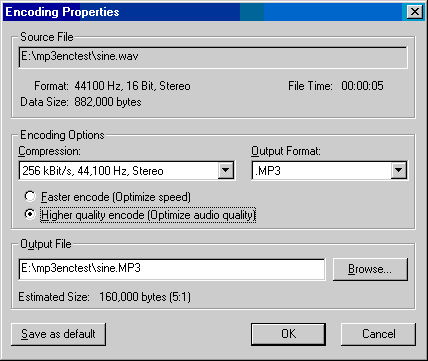 Audioactive Production Studio v.1.5.4The differences of this encoder from the predecessor are minimum. The code was more modified for reaching the top speed however the quality of coding has suffered. The interface of the program has remained without changes and that is reasonable as it is rather difficult to create something more convenient for coding a plenty of files. Blade Encoder DLL v.0.91At researches Blade Encoder was not used itself but its DLL version was. The code of this encoder is based on demonstration variant ISO of the code differing only by significant optimization on speed of coding. As the program operating this library the sound editor GoldWave was taken. There are both possibility of coding of one file and special mode of mass coding in it. As well as for Production Studio there is a possibility to save the encoded signal both as MP3 file and as WAV. However this possibility should be related more to GoldWave than to Blade Encoder. Among changed parameters of coding it is possible to point channel (STEREO or MONO), bit rate and sampling rate of result - it is quite enough for fast obtaining required result. However such quantity of customizations is not enough for the really most experienced user. GOGO DLL v.2.3 both Lame DLL v.3.7 and Lame DLL v.3.83These libraries of coding MP3 were used together with the very convenient program Easy a CD - DA Extractor intended for extract of sound tracks from musical compact discs. A basis for all three libraries is the code first GPL of an encoder LAME v.3.5 (Lame Ain't an MP3 Encoder). In turn this code initially is based on the demonstration code ISO that made distribution LAME under GPL impossible. However in May 2000 the last pieces of another code were completely copied and in the code LAME nothing common with ISO remained. It has allowed to begin distribution of the code under GPL however as the source texts on C. This fact is explained rather simply: the creator MP3 IIS Fraunhofer takes the definite sum from all corporations distributing encoders for usage of the standard irrespective from a sort of the license distribution. Thus at distribution of an encoder under GPL the corporation does it to its loss. At the same time initial codes are not an encoder and consequently are not taxed from IIS Fraunhofer. Without violation of the law, the compiled encoder can be used only by person, compiled it. However in the Internet all the same it is possible to find the compiled versions of an encoder. Besides many corporations use the initial codes LAME for inclusion of support MP3 in the products. Thus used libraries have appeared. First of them, under the statement of the writers, differs from LAME v.3.5 only by speed of operation. The rest of them are only the direct usage newer versions of the code LAME as plug-in to Easy CDDA Extractor. The main feature of the LAME code is absolutely new (created by the writers of the project) LAME psychoaucoustic model named G-psycho. It seems to be closer to real features of human hearing than model of competing commercial products. 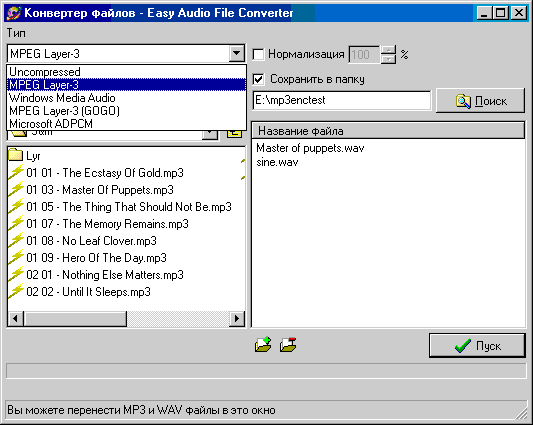 The library GOGO as parameters of coding allows to point the channel of a signal and the choice is carried out between STEREO, JOINT STEREO and MONO. For every channel it is possible to install sampling rate 44.1 and 22.05. For 44.1 minimum bitrate is 112 Kbps, for 22.05 - 56 Kbps. Besides for every bitrate there is a possibility to include usage VBR. In such case indicated bitrate becomes minimum admitted at coding. Maximum bitrate for VBR is always 320 Kbps. Libraries LAME have another possibilities. They also allow pointing channel of a signal with similar choice between STEREO, JOINT STEREO and MONO. However irrespective of sampling rate bitrate can receive all spectrums of values from 8 Kbps up to 320 Kbps. Moreover due to support of the extension standard MP3 MPEG Layer 2.5 there are no problems with choice of sampling rate because the sampling rate for coded and original signal will coincide. For any combination channel and bitrate there is a possibility to select a mode of operation of an encoder - maximum qualitative, standard and fast. The features of distinction quality of these modes are given below in the brief description Lame v.3.61. It is necessary to note one unpleasant feature of LAME DLL v.3.7 - there is bug because of which extra information is added in the end of the encoded signal. It occurs because of buffering writing coded data on disk when instead of the last incomplete information block smaller size of the buffer all buffer is written wholly. However it does not influence quality of coding a signal and therefore it doesn't create problems at realization of researches. Nevertheless after realization of the tests for 256 Kbps it was decided to eliminate this encoder from researches, as the users will hardly begin to use an encoder with such obvious error irrespective from the quality of result given out by it. Lame v.3.61This encoder also belongs to
the set Lame however as against three previous libraries it is the quite
independent cantilever program Win32. For its compilation Microsoft Development
Studio v.5.0 was used. The process of compilation has passed perfectly
and the successful result was achieved from the first attempt. L3Enc v.2.61 and MP3 Producer v.2.1 Professional and MP3Enc v.3.0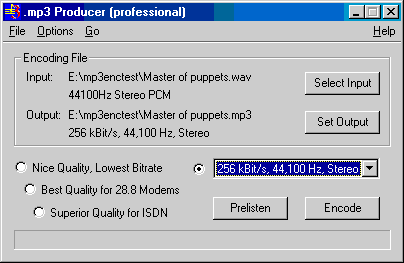 This bar of encoders represents commercial products of the creator MP3 - IIS Fraunhofer and accordingly is based on the authoring code. The only encoder having any graphic interface is MP3 Producer. However interface is rather inconvenient as for coding a plenty of files there is no possibility to install parameters of coding. There is a possibility to install bitrate and channel for coding one file however installation of a concrete type channel for stereo is carried out automatically depending on bitrate. The two-cantilener encoders have the similar disadvantage. Maximum bitrate of an output file is 256 Kbps, minimum - 18 Kbps for stereo and 8 Kbps for mono.  While the possibilities of customizations parameters of coding for L3Enc and MP3 Producer coincide in main, MP3Enc differs by the greater flexibility. For example it allows to install 10 different degrees of saving of quality (or speed of operation) or to point what frequency filters should previously be applied to an original signal. In the whole set of its customizations coincides with other not less power cantilever encoder Lame v.3.61. Microsoft WMAThis format of coding audio information became the second attempt of Microsoft to storm the problem of compression a sound. In 1995 the corporation loved by everybody was engaged in active progress and propagation the format of compression Microsoft ADPCM in which only 4 bits was on sample instead of 16. Besides sense of the stored information was considerably changed: if for usual PCM format the value of sample is equally to signal level at the given moment, for ADPCM it became equal to offset of a signal level concerning the previous instant. In the advertisement brochures it was said that the distortions which are brought in such a way of coding are absolutely imperceptible on hearing, however in a reality the frequency higher than 15 kHz were killed on the radical that made this way of compression inapplicable for storage of the sound data CD qualities. Windows Media Audio was created rather recently and is based on the method of coding similar to MP3. On hearing this format produces practically indistinguishable from MP3 result that has made WMA a rather strong competitor. Therefore it was decided to carry out researches with involvement WMA to estimate which format gives better quality of coding. The absence of support bitrate higher than 160 Kbps and complete uncertainty about the type of channel became the essential disadvantage of WMA. However in case of success of this format Microsoft will certainly improve it that will call instant response from competing IIS Fraunhofer. Thus it is possible to name appearance WMA as the beginning the era of hard competition formats of sound compression that will lead to raise quality of coding. The encoder WMA differs from encoder's MP3 by its "uniqueness". It is installed with other system codec's Windows 9x as one more format of compression of sounds. After that all based on MCI players start to recognize the new format of the sound data. Besides in similar applications there is a possibility of converting of the sound data in WMA. One of such programs is special plug-in to Winamp "out_wma.dll". With its help WMA files that have taken part in research were created. Their decoding was made with the help GoldWave which can work with the MCI-interface. The signal obtained after decoding passed the processing similar to decoded MP3 signals. As maximum bitrate for WMA is equal 160 Kbps it was decided to carry out small research for quality of coding MP3 with this bitrate. The best encoder by the results of the tests for 128 and 256 Kbps was chosen as the encoder MP3 to which WMA was compared. SCMPX v.1.5.1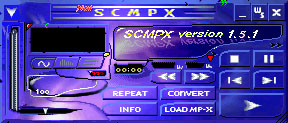 This program as a matter of fact is not an encoder MP3 but a whole miniature studio for playing, creation and processing MP3 and WAV files. The interface is very similar to Winamp however the principle of operation is absolutely another. If Winamp is only "shell" for various plug-in of players, SCMPX is the "monolithic" program, which code of operation with MP3 "is hardwired" rigidly in main executable file. The program is freeware and the encoder built - in it and decoder MP3 is written by the writer completely independently with usage of documentation ISO on standards MPEG. Thus MP3 received as a result of operation is not connected with IIS Fraunhofer in any way and is compatible only with audio encoders MPEG1 and MPEG2. However luckily MP3 from IIS Fraunhofer also is compatible with these audio decoders. It turns out that SCMPX MP3 and IIS Fraunhofer MP3 are compatible among themselves! It is surprising, isn't it?  However we shall return to possibilities SCMPX. So there is a support of bitrates from 32 Kbps that 320 Kbps, possibility of inclusion VBR, choice the type of channel, method of compression MPEG Layer I, II or III. There are two modes of coding - fast and standard. The speed of coding at usage of the fast mode is approximately twice more than standard. For completion it is necessary to mention the phrase present in the window of choice parameters: "NOTE: For completion of coding a lot of time is necessary!". Nevertheless this speed is two times more GOGO DLL that is one of the fastest researched encoders. For the judges Intel it is necessary to mention support MMX but it is difficult to surprise anybody by this. Streambox Ripper v.2.009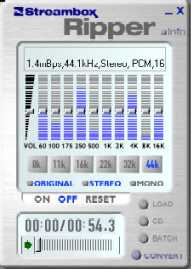 This encoder excels by the very beautiful and rather convenient interface. Except support MP3 there is also support WMA. The quantity of formats files read by it is amazing. Except standard WAV and MP3 it can read out RM, RA, RMM and tracks musical CD. The encoder MP3 is based on the code IIS Fraunhofer L3Enc therefore possibilities at the choice of parameters of coding completely coincide with L3Enc. As well as for MP3Enc and for Lame v.3.61 there is a possibility previously to skip the data through a frequency filter realized as an equalizer. There is a possibility of processing a plenty of files at once and the encoder will independently select all sound files supported by it from the indicated directory and will honesty recode them in the selected format making (where it is necessary) resampling, downmixing and similar to them operation. 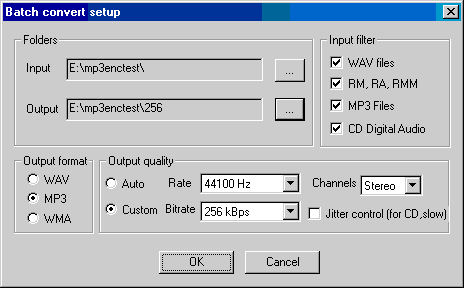 XingMPEG Encoder v.2.20 This encoder developed by the corporation XingTech differs from all others by record high speed of coding. The code of compression was developed completely by XingTech similar to how it was made in SCMPX. The interface of an encoder is directed obviously to the side of maximum simplification of life to the user. For this purpose the special concept of the template of compression representing just the defined combination parameters of compression designated by the own name is taken. For coding it is necessary to create new "operation", to select the template for this operation and to enjoy the fast obtained result. Complexity in creation of new templates became the reverse side of simplicity- at first encoder will take the user through long and senseless wizard and only after that will enable of simultaneous editing of all parameters. Complexity is also consists in the fact that except audio this encoder can encode and video and because of that it is necessary to fill in zero in all records concerning to MPEG video-stream. Bitrates from 8 Kbps up to 384 Kbps, three sorts of channel (STEREO, DUAL CHANEL, JOINT STEREO), three sampling rate 32000, 44100 and 48000 and also two sorts MPEG1 Layer II and III are supported. 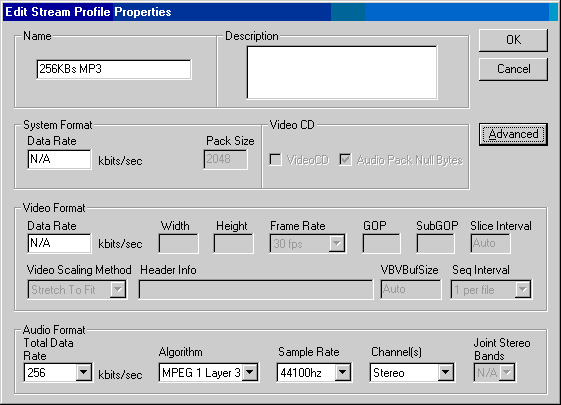 Results of testingSystem configuration on which all tests were carried out:
As main operating system Windows98SE was used. The testing was carried out in three "categories": 256 Kbps, 128 Kbps and 160 Kbps and VBR (Near 160). There are no questions with first two categories but it is necessary to explain why the results for 160 Kbps and VBR are joined. So what does VBR MP3 file represent? It is the usual MP3 file in which each information block can be encoded with different bitrate depending on sort of the sound data in each moment. Thus a little bit better coding of a signal is carried out at a smaller size of the resulting file. As at coding a sound with usage VBR bitrate 112 Kbps was selected as minimum and bitrate 256 Kbps as maximum, average value of bitrate must be about 180 Kbps. However according to the sizes of the obtained files this value was hardly more than 160 Kbps. From the definition VBR it is possible to expect that the quality of coding can be better than at coding with constant bitrate equal to average bitrate VBR as in the case VBR the quality of coding dynamically varies depending on a signal. Therefore it was made a decision to compare VBR MP3 with static MP3 with bitrate 160 Kbps hardly smaller than average bitrate obtained VBR MP3. All encoders were compared to "ideal" parameters - values ADS and ADW for standard difference. It allows not only to estimate quality of coding (its minimum value) but also to compare it for various bitrates and encoders. As an encoded signal approximately 55 seconds from the beginning of the song "Master of Puppets" group "Metallica" from an album "S&M" - fulfilment together with the New York symphonic orchestra was chosen. At first the signal was read out from CD with usage Easy a CDDA Extractor then it was cut off till about 55 seconds and it is saved in WAV the file with parameters "PCM 44100 ÊHz16 bit Stereo". The standard value ADS for such file format is equal 210, ADW - 270. However for each concrete man these values can a little vary, and with the purpose of applicability of results for any man these values were reduced by 20 units. (Unit in this case is equal to a minimum possible difference of a level of signals. For 16 bits of a sound all there are 65536 different levels.) The quality of coding was estimated not only on ADS and ADW, but also method of direct matching on hearing. Sharp discrepancies of results on ADS and ADW with a subjective estimation of sounding quality it was revealed not. 128 Kbps
So, the results of researches for most popular in Internet bitrate are rather unfavorable. The quality of coding even for the leader Lame DLL v.3.83 Fast Mode in 4 times is worse than the measurement standard. It does not mean that to distinguish on hearing an encoded signal from initial it is possible without problems - the study of psychoacoustic model plays a huge role there. Nevertheless probability of various sounding signals is very high and saving "CD qualities" is impossible. Having a look at the results from the point of view of the used codes it is possible to note such legitimacy: Lame in the fast mode gives about 26,5 %, newer code from IIS Fraunhofer MP3Enc gives 2 % of backlog (93 % Lame) with a quality factor 9 and 3 % (88 % Lame) with a quality factor 0. Numerous clones of the first variant of the code IIS Fraunhofer and Lame in the mode of excellence follows further - backlog 3-5 % (80-88 % Lame). Based on the specification ISO encoders lag behind on 10 % (62 % Lame) and close the table as much as possible optimized on speed SCMPX in the fast mode and code from XingTech - backlog on 18 % (32 % Lame) that is more than three times. The code WMA from Microsoft on a level is approximately equal to best of encoders IIS Fraunhofer - 2,5 % (90 % Lame) backlog from Lame. For first "feeler" in the field of high quality formats compression of sounds it more than well. 256 Kbps
First seen is more than triple exceeding of a lower rod quality 128 Kbps while at a rate the difference is doubled. Besides practical impossibility to tell on hearing an encoded signal with bitrate 256 Kbps from initial gets the explanation. At a level of change in 1,4 times more than standards psychoacoustic model brings to nothing all distinction of signals. Thus it is possible to maintain that 99 % of all signals encoded with bitrate 256 Kbps on hearing ñan't be told from initial. However as the coding gives result a little bit worse standard, it is possible to find such signal, which can be told from initial on hearing but it will be improbable to meet such signal among usual music. Continuing to examine results from the point of view the used codes for this bitrate it is possible to state a complete victory Lame - 74,4 %, and in this case mode of excellence really gives a little bit better result than fast (except LAME DLL v.3.7, where bug appeared especially strongly in the high-quality mode - not only the end of the file suffered but also its beginning). However this difference is minimum - 0,2 % and in this case it is reasonable to prefer the greater speed of coding. As well as for 128 Kbps the newer code from IIS Fraunhofer follows Lame, however percent of backlog this time is greater - for a quality factor 0 it is 6 % (92 % Lame) and for a quality factor 9 - 10 % (86 % Lame). Older code from IIS Fraunhofer - backlog about 12.5 % (82 % Lame) follows further. Then there are ISO encoders and the first variant equal to them of the code IIS Fraunhofer L3Enc - 15 % of backlogs (78 % Lame). The list is closed by the champion on speed from XingTech - 25 % of backlog (66 % Lame). In results the defined legitimacy is visible. For bitrate 256 Kbps the code from IIS Fraunhofer gives better quality in faster mode of coding and Lame - in slower one. For bitrate 128 Kbps the situation is fulfilled just what isn't needed. From here it is possible to make output: the code IIS Fraunhofer is optimized for operation on low bitrates and Lame - on high ones. Nevertheless psychacoustic the model Lame in the fast mode (and therefore with a plenty of the disconnected filters) all the same has become more suitable for coding with bitrate 128 Kbps despite of obvious non-optimized under this bitrate. On the other hand code from IIS Fraunhofer it is not optimized under bitrate 256 Kbps and consequently the disconnecting a part of psychoacoustic model lead to improvement quality of coding - model is too strict for this bitrate. 160 Kbps and VBR (Near 160)
Recently coding MP3 with VBR becomes very popular. It is considered that the resulting quality for the file will be better than for similar on a size but with hard bitrate as one set parts of a signal hard bitrate is more than enough for coding but for another set hard bitrate is not enough. Arranging bitrate on the file depending on a level of the requirements it is theoretically possible to achieve better quality of coding. Is it really so? The results show that it is not. Though all VBR MP3 were of a little bit greater size than their static colleagues, the least maximum level of distîrtions has remained for Lame - in 2.8 times worse than measurement standard. Comparing results from 128 Kbps we receive improvement a lower rod of quality in 1,45 times at increase of a file size in 1,25 times. Relative insignificance of this bitrate proves the fact of the significant superiority quality of coding the fast mode above high quality. Microsoft WMA has lagged behind from Lame on 6 % (83 % Lame) that again confirms gravity of intentions Microsoft concerning high-quality audio compression. 320 Kbps (that "ideal")
These two tests were carried out only out of curiosity with the purpose to determine whether it is possible with using of coding MP3 to receive ADS and ADW equal or smaller standard. As it is found out it is possible however compression in such case is carried out in 4.5 times from initial WAV file. The difference between the mode of coding excellence and fast coding became even more significant than for bitrate 256 Kbps - 5 %, however for values quality of coding more than 100 % any differences are absent or infinitesimal as human hearing can't be able to note the difference between two such signals irrespective of character distortions. SummarySo, we shall summarize testing. As the best encoder it is possible without any doubts to name Lame DLL v.3.83 - that is newest version of the code Lame (dated back by June 2000). For low bitrates (lower than 192 Kbps) it is necessary to use the fast mode of coding as psychoacoustic model G-psycho differs by complexity (as well as human brain, it is the model of its sensitivity to sounds) absolutely unnecessary on low bitrates when a bar of the data hardly suffices on transmission of low frequencies, let alone high and "thin" differences between them. At usage of the fast mode the most part of complex logic G-psycho is disabled and though the encoder starts mercilessly to cut frequencies the result all the same turns out on sounding a little bit better than for the competitors. For maximum bitrates G-psycho even in the fast mode is rather exact, as it is not necessary for it to try to be laid in close frameworks bitrate. However complete G-psycho will produce a little bit better result but this improvement does not cost decreases three times the speed of coding. The encoder from XingTech has become the worst.. At optimizing the code on speed the writers too simplified psychoacoustic model for what the encoder has paid by bad quality. So MP3 file obtained by this encoder with bitrate 256 Kbps on quality is approximately equal MP3 to the file obtained with the help Lame DLL v.3.83 with bitrate192 Kbps. Best of VBR encoders was GOGO DLL v.2.3 however usage VBR is set under the large question as smaller on a size MP3 with fixed bitrate was more qualitatively VBR MP3. However between GOGO and LAME there is a large difference and for static bitrate component about 1.25 times for bitrate 128 Kbps. Therefore bad result for VBR can be related simply to absence of its support by a good encoder. The separate mention is deserved by the format Microsoft WMA. As a whole it has become even better than its direct competitor- MP3 from IIS Fraunhofer having lost only to advanced Lame. By the obtained results it is also possible to outline frameworks of applicability each of bitrates. Very first of "CD qualitative" (128 Kbps) unfortunately is good only by small size of files - compression in 11 times. Therefore it can be recommended to pass a sound through networks with small capacity, that Internet for example is. Bitrate160 Kbps sounds a little better than 128 Kbps and consequently it is possible to recommend it for storage of "ephemeral" music - the quality is quite good for organization of discos however insufficient for the really requiring judge of a digital sound. Bitrate 256 Kbps is necessary for saving that "CD qualities" - in overwhelming majority of cases to differ the encoded information from the original it will be impossible. Bitrate 320 Kbps was used only when coding with usage 256 Kbps give heard distortions of a signal. However such situation is rather improbable. Write a comment below. No registration needed!
|
Platform · Video · Multimedia · Mobile · Other || About us & Privacy policy · Twitter · Facebook Copyright © Byrds Research & Publishing, Ltd., 1997–2011. All rights reserved. | ||||||||||||||||||||||||||||||||||||||||||||||||||||||||||||||||||||||||||||||||||||||||||||||||||||||||||||||||||||||||||||||||||||||||||||||||||||||||||||||||||||||||||||||||||||||||||||||||||||||||||||||||||||||||||||||||||||||||||||||||||||||||||||||||||||||||||||||||||||||||||||||||||||||||||||||||||||||||||||||||||||||||||||||||||||||||||||||||||||||||||||||||||||||||||||||||||||||||||||||||||||||||||||||||||||||||||||||||||||||||||||||||||||||||||||||||||||||||||||||||||||||||||||||||||||||||||||||||||||||||||||||||||||||||||||||||||||||||||||||||||||||||||||||||||||||||||||||||||||||||||||||||||||||||||||||||||||||||||||||||||||||||||||||||||||||||||||||||||||||||||||||||||||||||||||||||||||||||||||||||||||||||||||||||||||||||||||||||||||||||||||||||||||||||||||||||||||||||||||||||||||||||||||||||||||||||||||||||||||||||||||||||||||||||||||